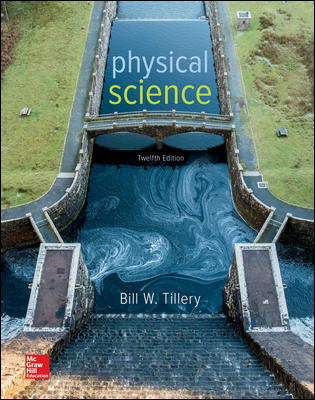Test Bank For Physical Science 12Th Edition By Bill Tillery
Original price was: $55.00.$34.00Current price is: $34.00.
Test banks are a compilation of questions created by the textbook author to test students’ knowledge of the key concepts in a particular subject area. Test Bank For Physical Science 12Th Edition By Bill Tillery is designed to help teachers better assess their students’ understanding of the material. The Test Bank For Physical Science 12Th Edition By Bill Tillery contains a wide variety of question types, such as multiple choice, fill-in-the-blank, and essay.
The questions are also organized by chapter, so teachers can easily create quizzes and exams that focus on specific areas of the text. In addition, the Test Bank For Physical Science 12Th Edition By Bill Tillery provides answer keys for all of the questions, making it an invaluable tool for both teachers and students.
Digital item No Waiting Time Instant Download
ISBN10: 1260150542 ISBN13: 9781260150544
Description
Test Bank For Physical Science 12Th Edition By Bill Tillery
Physical Science, 12e (Tillery)
Chapter 1 What is Science?
1) The property of mass is a measure of how heavy an object is.
2) A referent is a familiar object one can use to describe the property of an object.
3) Measurement information used to describe something is called data.
4) A 100 g piece of iron has twice the volume as a 50 g piece of iron.
5) The mass of 1000 cm3 of water is a kilogram.
6) The density of a 100 g piece of iron is twice as great as the density of a 50 g piece of iron.
7) A controlled experiment has all variables held constant.
8) The symbol µ has the meaning of “is proportional to.”
9) A theory is a hypothesis that has been shown to be correct by many experiments.
10) The symbol “∆” is used to refer to an object’s density.
11) Equations are used to
A) describe a property.
B) define a concept.
C) describe how quantities change together.
D) All of the answers are correct.
12) Which of the following is NOT a SI unit of the property it measures?
A) length—meter
B) volume—liter
C) time—second
D) mass—kilogram
13) In the text, the equation V = tk is used to describe the relationship between the volume of a gas tank and the time required to fill it. The symbol “k“
A) has units of min/gal.
B) is a variable.
C) is the proportionality constant.
D) depends on the length of time.
14) The English unit of volume closest in size to a liter is
A) gallon.
B) ounce.
C) quart.
D) cup.
15) If a cube of Jell-O gelatin dessert is cut into two pieces, what total property of the new pieces change?
A) mass
B) volume
C) density
D) surface area
16) When something cannot be directly observed, it can be represented by a
A) hypothesis.
B) graph.
C) model.
D) theory.
17) Claims that appear to be pseudoscience should be
A) accepted if it is said to have scientific validity.
B) tested experimentally.
C) accepted if promoted by news media.
D) All of the answers are correct.
18) The property of volume is a measure of
A) how much matter the object contains.
B) the compactness of matter in a given space.
C) the extent of the surface of the object.
D) how much space the object occupies.
19) In the equation A = πr2, π (pi) is a
A) manipulated variable.
B) responding variable.
C) numerical constant.
D) constant that depends on the size of the circle.
20) The re-creation of an event by comparing two situations in which all the factors are identical except one is called a
A) tentative experiment.
B) cause and effect demonstration.
C) statistical test of truth.
D) controlled experiment.
21) A tentative scientific explanation that may or may not be rejected upon further experimentation is called a
A) theory.
B) hypothesis.
C) model.
D) principle.
22) A statement describing a relationship that is observed in nature to occur consistently time after time is a(an)
A) hypothesis.
B) scientific law.
C) scientific theory.
D) model.
23) Imagine a 10 g chunk of aluminum (r = 2.7 g/cm3) and a 10 g chunk of iron (r = 7.9 g/cm3). Which of the following is true?
A) The chunk of iron is smaller than the chunk of aluminum.
B) The chunk of iron is more massive than the chunk of aluminum.
C) The chunk of aluminum is smaller than the chunk of iron.
D) Both objects have the same volume.
24) A cube that measures 2 cm on each side has a surface area to volume ratio of
A) 1/2.
B) 2.
C) 3.
D) 6.
25) A scheme of thought that has survived a test of detailed examination for long periods of time is a(n)
A) hypothesis.
B) scientific law.
C) scientific theory.
D) model.
26) The most recently developed scientific theory is the
A) plate tectonic theory.
B) atomic theory.
C) theory about the nature of light.
D) theory of evolution.
27) One of the basic differences between science and a pseudoscience is the lack of
A) data.
B) valid and reliable experimental studies.
C) testable hypotheses.
D) theories.
28) A tentative thought- or experiment-derived explanation is known as a(an)
A) hypothesis.
B) scientific law.
C) scientific theory.
D) model.
29) An event with two situations with all the influencing factors identical except one is a(n)
A) hypothetical experiment.
B) experiment.
C) controlled experiment.
D) impossible experiment.
30) An experimental situation used as the basis of comparison is the
A) control group.
B) experimental group.
C) hypothetical group.
D) group of variables where changes will occur.


Be the first to review “Test Bank For Physical Science 12Th Edition By Bill Tillery”